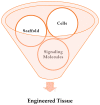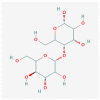Development of Scaffolds from Bio-Based Natural Materials for Tissue Regeneration Applications: A Review
- PMID: 36826270
- PMCID: PMC9957409
- DOI: 10.3390/gels9020100
Development of Scaffolds from Bio-Based Natural Materials for Tissue Regeneration Applications: A Review
Abstract
Tissue damage and organ failure are major problems that many people face worldwide. Most of them benefit from treatment related to modern technology's tissue regeneration process. Tissue engineering is one of the booming fields widely used to replace damaged tissue. Scaffold is a base material in which cells and growth factors are embedded to construct a substitute tissue. Various materials have been used to develop scaffolds. Bio-based natural materials are biocompatible, safe, and do not release toxic compounds during biodegradation. Therefore, it is highly recommendable to fabricate scaffolds using such materials. To date, there have been no singular materials that fulfill all the features of the scaffold. Hence, combining two or more materials is encouraged to obtain the desired characteristics. To design a reliable scaffold by combining different materials, there is a need to choose a good fabrication technique. In this review article, the bio-based natural materials and fine fabrication techniques that are currently used in developing scaffolds for tissue regeneration applications, along with the number of articles published on each material, are briefly discussed. It is envisaged to gain explicit knowledge of developing scaffolds from bio-based natural materials for tissue regeneration applications.
Keywords: fabrication techniques; scaffold; tissue engineering; tissue regeneration.
Conflict of interest statement
The authors declare no conflict of interest.
Figures














References
-
- Koons G.L., Diba M., Mikos A.G. Materials design for bone-tissue engineering. Nat. Rev. Mater. 2020;5:584–603. doi: 10.1038/s41578-020-0204-2. - DOI
-
- Eltom A., Zhong G., Muhammad A. Scaffold Techniques and Designs in Tissue Engineering Functions and Purposes: A Review. Adv. Mater. Sci. Eng. 2019;2019:3429527. doi: 10.1155/2019/3429527. - DOI
-
- Tan H.-L., Kai D., Pasbakhsh P., Teow S.-Y., Lim Y.-Y., Pushpamalar J. Electrospun cellulose acetate butyrate/polyethylene glycol (CAB/PEG) composite nanofibers: A potential scaffold for tissue engineering. Colloids Surf. B Biointerfaces. 2020;188:110713. doi: 10.1016/j.colsurfb.2019.110713. - DOI - PubMed
Publication types
Grants and funding
LinkOut - more resources
Full Text Sources

